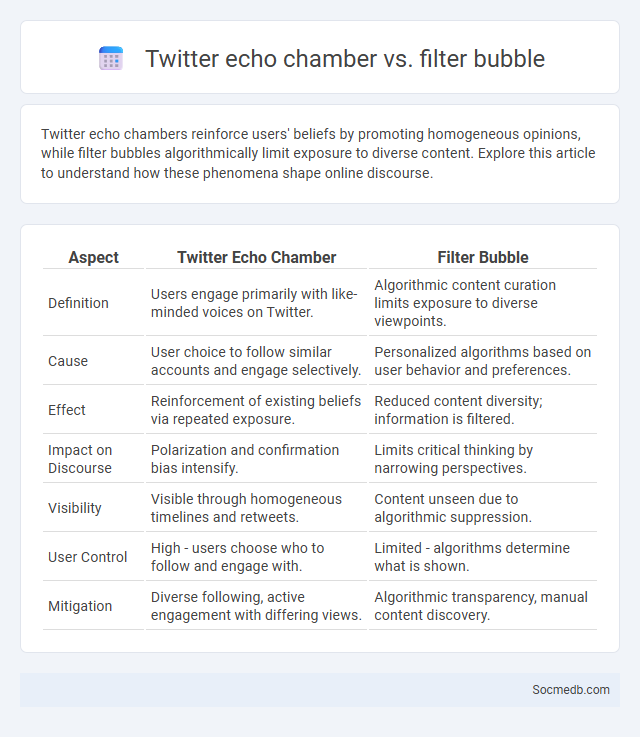
Photo illustration: Twitter echo chamber vs filter bubble
Twitter echo chambers reinforce users' beliefs by promoting homogeneous opinions, while filter bubbles algorithmically limit exposure to diverse content. Explore this article to understand how these phenomena shape online discourse.
Table of Comparison
| Aspect | Twitter Echo Chamber | Filter Bubble |
|---|---|---|
| Definition | Users engage primarily with like-minded voices on Twitter. | Algorithmic content curation limits exposure to diverse viewpoints. |
| Cause | User choice to follow similar accounts and engage selectively. | Personalized algorithms based on user behavior and preferences. |
| Effect | Reinforcement of existing beliefs via repeated exposure. | Reduced content diversity; information is filtered. |
| Impact on Discourse | Polarization and confirmation bias intensify. | Limits critical thinking by narrowing perspectives. |
| Visibility | Visible through homogeneous timelines and retweets. | Content unseen due to algorithmic suppression. |
| User Control | High - users choose who to follow and engage with. | Limited - algorithms determine what is shown. |
| Mitigation | Diverse following, active engagement with differing views. | Algorithmic transparency, manual content discovery. |
Introduction to Twitter Echo Chambers and Filter Bubbles
Twitter echo chambers and filter bubbles occur when algorithms prioritize content that aligns with Your existing beliefs, limiting exposure to diverse perspectives. This phenomenon reinforces confirmation bias by continuously feeding similar viewpoints, reducing critical thinking and open dialogue. Understanding these mechanisms is essential for navigating social media critically and broadening Your information intake.
Defining Echo Chambers in Social Media
Echo chambers in social media refer to environments where Your online interactions are primarily confined to like-minded individuals, reinforcing existing beliefs without exposure to differing viewpoints. These digital spaces utilize algorithms that prioritize content aligning with Your preferences, limiting diversity in information and perspectives. Understanding echo chambers is essential to recognizing how social media shapes opinions and potentially polarizes discourse.
What is a Filter Bubble?
A filter bubble is a state of intellectual isolation that occurs when algorithms used by social media platforms selectively expose users to content that aligns with their existing beliefs and preferences. This personalized filtering limits exposure to diverse perspectives, reinforcing confirmation bias and reducing critical thinking opportunities. As a result, users become trapped in echo chambers that hinder meaningful discourse and the understanding of broader societal issues.
The Mechanics of Echo Chambers on Twitter
Echo chambers on Twitter form through algorithm-driven content curation that prioritizes user engagement by repeatedly exposing individuals to like-minded opinions and reinforcing existing beliefs. The platform's recommendation system amplifies homogenous content clusters, limiting exposure to diverse perspectives and intensifying polarization. User behavior, including selective following and retweeting patterns, further entrenches these echo chambers by creating insulated communities resistant to dissenting viewpoints.
How Filter Bubbles Influence Twitter Feeds
Filter bubbles shape your Twitter feed by curating content based on your previous interactions, interests, and engagement patterns, limiting exposure to diverse viewpoints. This algorithm-driven personalization reinforces existing beliefs and preferences, creating an echo chamber that narrows the information scope. Understanding filter bubbles is crucial for balancing your news intake and promoting a more open, critical perspective on social media.
Key Differences: Echo Chamber vs. Filter Bubble
Echo chambers on social media arise when users engage predominantly with like-minded individuals, reinforcing existing beliefs through repeated exposure to similar viewpoints. Filter bubbles result from algorithmic personalization, where platforms curate content based on user behavior, limiting exposure to diverse perspectives. While echo chambers involve active social interaction within homogeneous groups, filter bubbles are passive, shaped by data-driven content delivery systems.
Social and Psychological Impacts of Twitter Echo Chambers
Twitter echo chambers intensify social polarization by reinforcing users' preexisting beliefs and limiting exposure to diverse perspectives, leading to increased cognitive bias and groupthink. These environments contribute to psychological effects such as heightened anxiety, reduced critical thinking, and decreased empathy toward opposing viewpoints. Studies reveal that echo chambers on Twitter amplify misinformation, further entrenching social divides and impacting mental well-being.
Case Studies: Real-World Effects on Twitter Users
Case studies on Twitter users reveal significant impacts of social media on mental health, including increased anxiety and depression linked to online harassment and misinformation exposure. Research highlights how viral trends and influencer interactions shape public opinion and consumer behavior, demonstrating Twitter's role as a powerful platform for social influence. Data-driven analyses emphasize the importance of digital literacy and content moderation policies to mitigate negative outcomes and promote healthier online environments.
Strategies to Break Free from Digital Echo Chambers
Breaking free from digital echo chambers requires actively diversifying your social media feeds by following accounts with varying viewpoints and engaging critically with contrasting perspectives. Utilizing platform tools to customize content algorithms minimizes the reinforcement of homogeneous ideas, promoting exposure to diverse information sources. Regularly questioning personal biases and seeking out reputable news outlets fosters a balanced understanding, reducing the impact of algorithm-driven filter bubbles.
Conclusion: Navigating Information Silos on Twitter
Twitter fosters diverse information silos that can limit your perspective by exposing you primarily to like-minded viewpoints. Actively seeking out varied sources and engaging with contrasting opinions helps break these silos and broadens your understanding. This approach enhances your ability to navigate complex discussions and make informed decisions.
 socmedb.com
socmedb.com